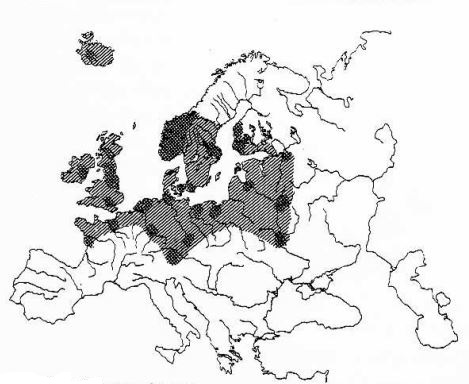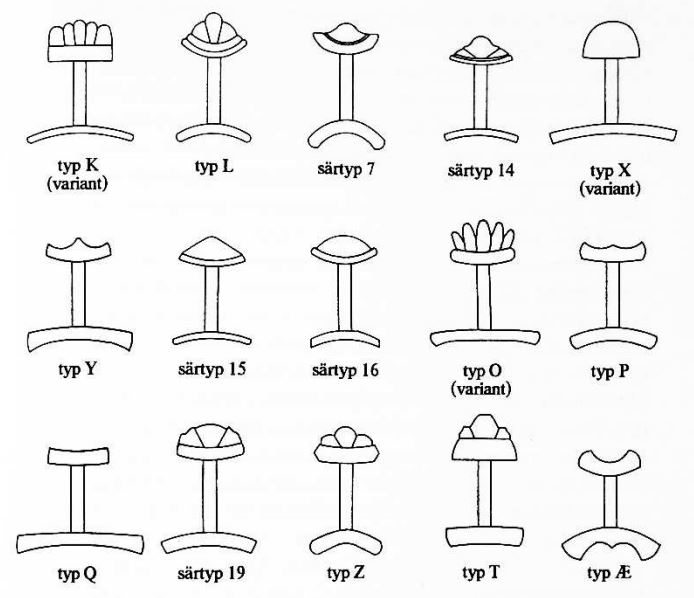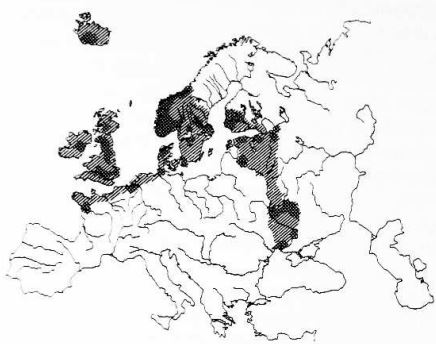Jan Petersen’s revolutionary thesis De Norske Vikingesverd (1919) became a basis for many authors, who attempted to adjust or complete the work, or replace it with a typology of their own. Such an example is Mikael Jakobsson, who chose a different approach in his thesis Krigarideologi och vikingatida svärdstypologi (Stockholm, 1992), which we analyse in the text below.
The book Krigarideologi och vikingatida svärdstypologi [Warrior ideology and typology of Viking Age swords], which is a published doctoral thesis of the author, is a reputable and very thorough work. Personally, I see its main benefit in advanced analysis using data collected from majority of Europe. His goal is not a revision of Petersen’s hilt typology – with which he basically agrees – but a categorisation of broader hilt groups based on similarities in construction. Jakobsson labels these categories as “design principles”. While Petersen worked with three principles (a group with multi-lobed pommel, a group with simplified pommel, a group of unclassifiable types), Jakobsson expanded the list to six, respectively seven types:
- Triangle pommel
- Three-lobed pommel
- Five or more-lobed pommel
- Absenting pommel
- Curved guard
- Single-pieced pommel
- Unclassifiable
Design principle 1 : triangular pommel
Jakobsson’s triangular pommel corresponds to Petersen’s main sword types A, B, C, H and I, plus his special types 3, 6, 8 and 15. The swords using this design principle comprise a substantial part of swords finds portfolio – at least 884 pieces (48%) according to Jakobsson. This equals to 529 swords in Norway (60%), 147 in Sweden (17%), 81 in Finland (9%), 4 in Denmark (0,5%), 94 in Western Europe (11%) and 29 in Eastern Europe (3%). Their origin can be traced to continental swords with pyramid-shaped pommels. This principle emerged in Scandinavia sometime between the half and end of 8th century under the influence of Carolingian swords and remained there until the end of 10th century.
Petersen’s sword types corresponding with Jakobsson’s design principle 1.
Distribution of design principle 1 pommels, areas of archaeological finds marked with black.
Design principle 2 : three-lobed pommel
The design principle 2 includes variants of type A, types D, E, L, Mannheim, Mannheim/Speyer, R, S, T, U V and Z, older variant of type X and special types 1, 2, 6, 13, 14 and 19. This principle is present at least on 492 swords (26%). This corresponds with 188 swords in Norway (37%), 58 in Sweden (12%), 43 in Finland (9%), 18 in Denmark (4%), 75 in Western Europe (15%) and 110 in Eastern Europe (23%). The origin can be traced to Merovingian swords, with the three-lobed pommel being based on a pommel with animal heads on the sides. This principle appeared in Scandinavia at the end of 8th century under the influence of Early-Carolingian swords, and supported by English influence in 9th century, it remained there until the beginning of 11th century.
Petersen’s sword types corresponding with Jakobsson’s design principle 2.
Distribution of design principle 2 pommels, areas of archaeological finds marked with black.
Design principle 3 : five and more-lobed pommel
Jakobsson’s design principle 3 includes Petersen’s sword types O, K and the five-lobed variant of type S. This principle is the least numerous with only over 88 swords (5%) and is tighly connected to the design principle 2. In Norway, there are 44 swords (49%), 4 in Sweden (5%), none in Finland, 1 in Denmark (1%), 26 in Western Europe (30%) and 13 in Eastern Europe (15%). Like design principle 2, also the design principle 3 is based on Merovingian pommels with animal heads on pommel sides. It arrived in Scandinavia at the beginning of 9th century and remained until the half of 10th century. The topic five and more-lobed pommels is vaguely analyzed, as there are more than fifty cast bronze pommels that are not included.
Petersen’s sword types corresponding with Jakobsson’s design principle 3.
Distribution of design principle 3 pommels, areas of archaeological finds marked with black.
Design principle 4 : absenting pommel
With its distinctive upper guard instead of a traditional pommel, design principle 4 includes main types M, P, Q, Y, Æ and special types 5, 17 and 18. We know of at least 712 swords (39%) belonging to this design principle. It is notable that the type M alone is the most numerous of all sword types with more than 432 finds (17%). As for the principle 4, we know of 631 swords in Norway (89%), 23 in Sweden (3%), 14 in Finland (2%), 2 in Denmark (0,3%), 28 in Western Europe (4%) and 14 in Eastern Europe (2%). Design principle 4 was in use from 9th century to sometime during 11th century.
Petersen’s sword types corresponding with Jakobsson’s design principle 4.
Distribution of design principle 4, areas of archaeological finds marked with black.
Design principle 5 : curved guard
This design principle of swords consists of main type L, Q, T, Y, Z and Æ, variants of types O, K and X, plus special types 7, 14, 15, 16, 17, 18 and 19. The number of swords belonging to design principle 5 is somewhere over 482 pieces (26%). In Norway, we know of 312 finds (71%), 32 in Sweden (7%), 23 in Finland (5%), 3 at maximum in Denmark (1%), 45 in Western Europe (10%) and 70 in Eastern Europe (6%). Design principle 5 was in use during the same period as design principle 4 – from the beginning of 9th century till the end of 11th century.
Petersen’s sword types corresponding with Jakobsson’s design principle 5.
Distribution of design principle 5, areas of archaeological finds marked with black.
Design principle 6 : single-pieced pommel
The distinguishing attribute for design principle 6, containing sword types X and W, is a single-pieced pommel with absenting upper guard. There are over 211 swords (11%) of this kind, with 69 found in Norway (33%), 25 in Sweden (12%), 46 in Finland (22%), 8 in Denmark (4%), 51 in Western Europe (24%) and 12 in Eastern Europe (6%). While Jakobsson suggested design principle 6 coming into use at the end of 9th century or the beginning of 10th century, Jiří Košta proved on a set of type X swords from Moravia area of Mikulčice that this principle could had been in use in Central Europe as early as 9th century. This principle turned out to be dominant and substantial for following medieval weapons.
Petersen’s sword types corresponding with Jakobsson’s design principle 6.
Distribution of design principle 6, areas of archaeological finds marked with black.
Unclassifiable
Out of the total of 1900 included swords, as much as 97% can be classified into one or more of the previous six design principles. The remaining 3% (around 60 swords) cannot be categorised as such, because they are either a combination of some of two principles or represent a completely standalone category.
Petersen’s sword types corresponding with Jakobsson’s unclassifiable category.
As the research shows, it is possible to see a certain evolution of the individual sword types, with a new type of sword per circa each new generation. On contrary, if we categorise the swords by Jakobsson’s design principles – thus working a wider group of sword types based on clearly defined attributes – the length of usage increases to over 100 years, in some cases even up to 200-250 years, i.e. 6-8 generations. Such a prolonged usage of similar manufacturing process undoubtedly must have a deeper meaning. At least in 10th century, all principles were used simultaneously, so it is not possible to connect different manufacturing processes with different chronology. The same goes with geographical distribution, as all principles were used in the similar area, and with practical features – design principle 1 has no connection between the pommel type and blade type, so we can come across both single- and two-edged swords. Jakobsson therefore suggests the popularity of six different principles being tied to something else entirely – to different strategies for reproducing a symbolical value tied to a physical form.
The symbolical value of swords goes hand to hand with their ownership and usage. The fact that the sword principles emerged in such volatile times filled with war, and that the swords are often found in graves suggests that their owners were perceived as sovereigns and combat capable figures. A sword is therefore a multi-layered expression of independence and legitimate membership of higher society (see The Biography of a Sword). This value was undoubtedly reflected by the visage of the sword, with some types or even whole principles being more suitable for such a presentation than others. Individual principles might have held a meaning we are not able to grasp anymore nowadays.
More traditional constructions (most of the principle 1, 2 and 3 swords) consist of heavier, usually decorated multi-pieced pommels and short guards, which are good especially for footed combat. In contrast to this conservative construction with deep roots in previous generations of Germanic weapons, there are lighter, less decorated swords with simple pommels, longer guards and better usage in mounted combat (principle 6, especially the type X). Their owners could had expressed their allegiance to continental aristocracy and fashion which the local elite promoted. This could also be the case of principle 5, which seems to be of Anglo-Saxon origin, with its features being widely replicated at least in Viking-Age Scandinavia. Principle 4 might had been more suitable for a part of population wishing to show their identity of sword owners but could not afford the previously mentioned principles. That is why Petersen’s type M is the most common sword of the Early Middle-Ages (see Petersen type M sword).
Last but not least, it is important to mention that the weapon distribution throughout Scandinavia was not uniform, and that there were notable differences between rich centres and less important peripheries. In closed communities, such as Iceland and some Scandinavian regions, the weapons were widespread among the population, but swords were held by only the richest and in small numbers. In major centres such as Uppland, Central Sweden (also known as society dividing model), the weapons were mainly owned by warrior nobility, circa in ratio 14 Petersen’s types per 100 swords. In this societal model, the presence and absence of weapons among the wider population is crucial. In contrast to this model stand the peripheries settled by seldom stratified population attempting to demonstrate its power. Such a demonstration usually takes form of cumulation of vast number of weapons (also known as society uniting model), which is based on quantity and quality. This can be seen both in number of swords found in Norway, counting over several thousands, and relatively high diversity of sword types, being 10-13 Petersen’s types per 100 swords in some areas. The vacuum created by absence of a central ruler is filled by number of lesser chieftains who represent their sovereignty by possession of exclusive equipment. Such a type of society, which uses more swords, preserves this trend and puts even more swords into circulation. Other reasons for the creation of Norwegian model could be interpreted by well-equipped militia, but also in other ways. According to Jakobsson, all the models are as a matter of fact a reflection of the same reality.
Jakobsson’s work is a semiotic approach to material culture. He attempts to outline a complex relation between a symbol and a context and does not resort only to a single explanation. His approach to the subject is by both analysing the sword categories from broader historical perspective and by considering each of the specific weapons by the local and minor relevance. Despite its useful analyses and extensive appendixes, the book does not receive enough attention after more than 25 years. Nevetherless, Jakobsson’s research should be revised in order to confirm or disprove its up-to-dateness.
I hope you liked reading this article. If you have any question or remark, please contact me or leave a comment below. If you want to learn more and support my work, please, fund my project on Patreon or Paypal.















4 responses
Thank you. I have the book with Michaels autograph but your article was very good for memorizing the contents. The book should have get more attention, but perhaps the problem is it being in Swedish. I hope your article will be read by many.
Thank you for your feedback, Marjatta!
Rich with information! Thank you, very much, for the insights and efforts expended creating this article, Tomáš.
Hello! Thank you very much using the text!